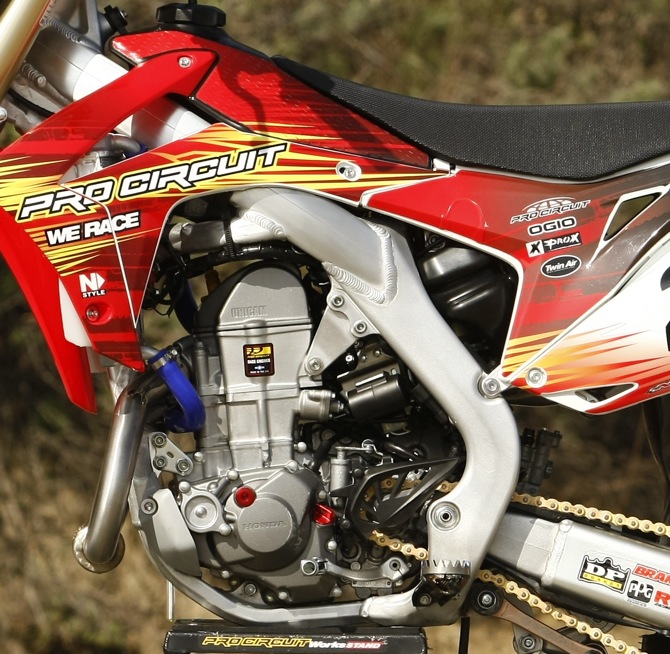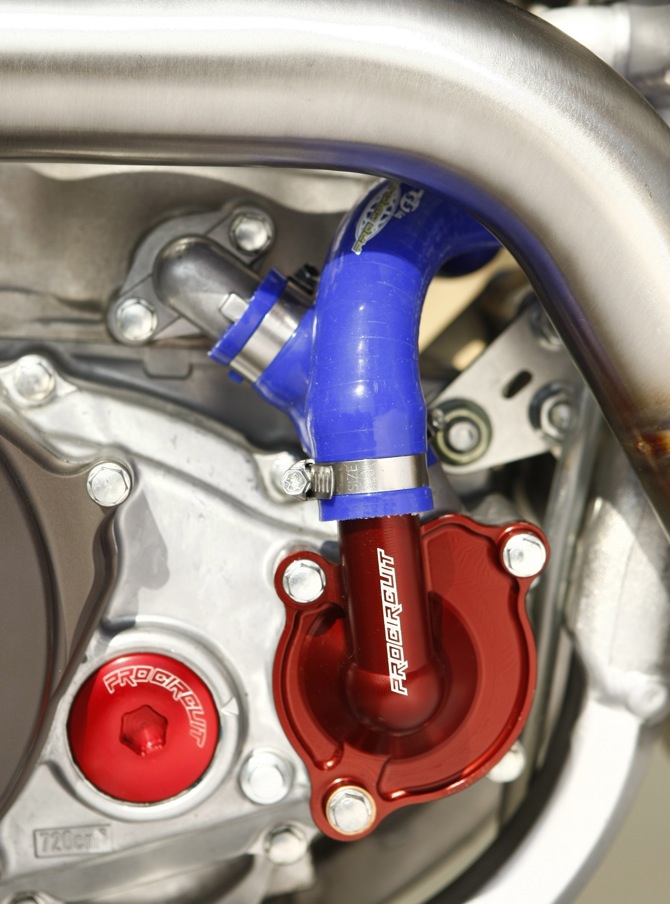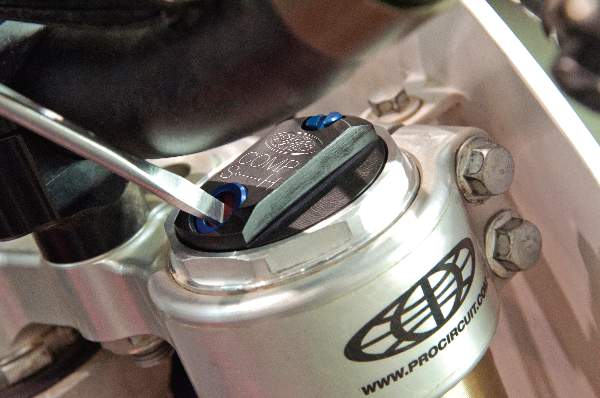WE RIDE PRO CIRCUIT’S 60-HORSEPOWER HONDA CRF450

The 2013 Honda CRF450 is the most discussed bike of the year, thanks in part to a new model change and because, to put it bluntly, it’s red. Honda has long held the attention of the buying public. Honda is known for their dominance during the 1980s, with racing greats such as David Bailey, Johnny O’Mara, Donnie Hansen and Ricky Johnson, continuing through the ’90s with Jeff Stanton and Jeremy McGrath, and onward to a new millennium with Ricky Carmichael and Trey Canard. A reputation for quality products galvanized their status as the brand by which all other manufacturers were measured. Honda’s peak, at least in MXA’s opinion, occurred in 2008. The CRF450 was the bike to beat. To this day, it’s still one of the best motorcycles ever made?and the CRF250 wasn’t far behind.
Surely you have figured out where this story is headed. In 2009, Honda made the fateful decision to start anew with the CRF450, turning it into a cellar dweller in “MXA’s 450 Shootout.” Quirky handling, a soft engine, confused suspension and a suspect clutch were the major culprits in the bike’s demise. We chastised the 2009?’12 CRF450s and were loathed by Honda as a result. Our relationship was strained, and rightfully so.
Fortunately, 2013 brought an updated CRF450, and with it new opinions from the MXA wrecking crew. Truth be told, we are much happier with the 2013 CRF450 than the previous generations. Honda addressed many of our complaints. The Kayaba Pneumatic Spring Fork (PSF) piqued our interest. And while we still haven’t swallowed the twin-pipe Kool-Aid, it’s something to talk about. The 2013 Honda CRF450 finished fourth in our shootout, but with a stronger engine, brakes, clutch and shock, it could have jumped up in the pecking order.

Pro Circuit spared no expense with the 2013 Honda CRF450. They threw everything but the kitchen sink at our bike.
A new year also brought hordes of aftermarket companies into the mix. Need proof? In the past four months, we have conducted a twin-pipe shootout, tested a handful of products (including a CRFStuff offset sprocket, which you can find on page 118), delved into Kayaba’s PSF system and ridden two CRF450 hop-up bikes. Thanks to Mitch Payton at Pro Circuit, we can add yet another bike to our ever-expanding list.
Mitch Payton needs no introduction. He’s the maestro behind the omnipotent Monster Energy Pro Circuit Kawasaki race team. With 30 titles and well over 200 race wins to their credit, Mitch’s team has long held court in professional racing. Payton also runs the extremely successful Pro Circuit aftermarket shop in Corona, California. Despite his accomplishments, Mitch is probably most proud of his skills as an engine tuner. He strives to find power where lesser men would fear to tread.
The 2013 Honda CRF450 was right in Payton’s wheelhouse. Coughing out an anemic 51.55 horsepower at 8900 rpm, the CRF450 had the weakest engine in the class. In other words, it was a prime opportunity for Mitch. It wasn’t as easy as he had envisioned. Mitch elaborates: “I found that it is a greater challenge gaining horsepower out of the 2013 engine than with the previous model. It took us a month and a half to get our engine package dialed. We tried a bunch of different strategies to improve power, but we weren’t satisfied for quite some time.” Finally, Mitch hit his mark, but not before scrapping a few ported cylinder heads and testing extensively on his dyno.

Pro Circuit squeezed close to 60 ponies out of the CRF450 engine. That power translated well to the track. It was a hit, literally.
BELOW IS THE BREAKDOWN OF WHAT MITCH DID TO OUR 2013 HONDA CRF450.
Engine. In Payton’s words, “The first engine modification we made was to port the cylinder head. That made the powerband better, so then we threw in a high-compression piston. That also helped. Once we put in the camshaft and valve springs, I thought we would have gotten to the point in performance where we were with the 2012 model. The engine still needed some revisions, so I ported a few more cylinder heads and tweaked the piston. Then, we came up with a cam that helped performance everywhere. I still wasn’t satisfied, though. I ported a few more heads, and then the whole package really came together and turned out well.”

Pro Circuit has developed new titanium exhaust valves ($357.95 each), a piston kit ($289.95) and a camshaft ($656.95) specifically for the 2013 model. Interestingly, the piston came from Chad Reed’s race specifications a few years ago and is nearly identical to what “Skippy” ran. All of these new parts represent just a fraction of the work done to our bike build. Payton also installed a valve-spring kit ($299.95), titanium intake valves ($357.95 each), and copper valve seats ($129.95). He also ported the cylinder head ($549.95). With our CRF450 engine modifications reaching well over $2500, perhaps you’re wondering if we have lost our minds. Quite the contrary. Power costs money. In fact, this is the same engine that David Philippaerts is racing with on the Grand Prix circuit. Mitch Payton summed it up best: “I think that you could line this bike up at any professional race?be it Supercross, the Nationals or the GPs?and it would be competitive with any of the factory bikes that are out there.”

Bones?Bacon worked his magic on the Kayaba PSF forks. Different valving and oil height did the trick.
Exhaust. In the March 2013 issue, we conducted a five-pipe, dual-exhaust shootout. The Pro Circuit Ti-5 system received high marks and was preferred by our Intermediate-level test rider. It finished inside the top three among our Novices and Pros. At that time, Pro Circuit was busy developing a single exhaust for the CRF450, but they didn’t get it finalized until nearly two months later.
What was the setback? “When we first got the 2013 Honda CRF450, we looked at the pipe and focused on making something better. That took some time,” says Mitch. “The stock pipe has really good bottom, but last year’s bike had more top-end power. We thought that we could gain that ground back with a different pipe. We managed to do that with our twin-pipe design, and then we focused on the single design. We weren’t able to duplicate the same bottom-end power as with the dual exhaust, but it’s pretty close. We wanted to offer the single exhaust to the guy who didn’t have as much money. The single can also be used at an Amateur race. It also comes with a spark arrestor.” [Note: simply put the insert in the muffler to pass the FIM two-meter-max sound test.] To compare, the Ti-5 dual exhaust retails for $1395, while the T-5 single (available in stainless steel only) is $779.95.
Suspension. Bones Bacon, Mitch’s right-hand man for suspension needs, went to work on the Kayaba units. Since the CRF450 comes with all-new suspension for 2013, Bones didn’t have many baseline settings to go off of. When word reached Bacon that Pro Circuit was building us a 2013 CRF450, he made us promise to help test a variety of suspension settings or else he would put the kibosh on our project. Although Bones is unimposing, we acquiesced. After all, it would be a valuable learning experience for us.

Bones started by revalving the fork internals ($196.98 for the kit and $194.95 for labor) and adding a bladder-cap kit ($58.85). Pro Circuit makes a really cool air-fork pump that has a digital gauge ($299.95), which he used to set the forks at 33 psi. As for the shock, he used a special Showa shock kit ($124.95) and also did a revalve ($119.75 for parts and $164.95 for the labor). The all-new Pro Circuit lowering link ($224.95) is 1mm longer than stock and changes the rising rate. Pro Circuit also included their new 20mm-offset triple clamps ($699.95).

Accessories. Pro Circuit recently began distributing Haan wheels. The Netherlands-based company has been in business for over 45 years and has quite a reputation. It was logical that Pro Circuit would want to showcase the Haan wheels by equipping our bike with them. The wheels come with Excel A60 rims, Haan hubs and stainless steel spokes that are 30 percent stronger than stock. The front wheel retails for $649.95, while the rear costs $749.95.

We tested both the dual exhaust and the single design. Most testers preferred the single, as it added more top-end power.
Mitch Payton also included Raptor titanium footpegs ($359.95), a Hinson clutch basket ($314.99) and inner hub/pressure plate ($499.99), an RK chain, Dunlop tires, VP race fuel, a Twin Air filter, and Renthal handlebars, grips and sprockets (standard gearing).

Pro Circuit products. Since this is a Pro Circuit-modified bike, our CRF450 was littered with P.C. goodies. The list includes a radiator hose kit ($204.95), clutch cover ($169.95), stiffer clutch springs ($79.95), water-pump cover with an impeller ($199.95), anodized engine plug kit ($99.95), axle blocks ($59.95), a Launch Control holeshot device ($109.95), brake snake ($16.95), and rear brake clevis ($54.95). The whole package was wrapped up in a graphics kit and seat cover by N-Style ($129.95).
It doesn’t take Dustin Hoffman in Rain Man to realize that our Pro Circuit Honda CRF450 bike build broke the bank. In no way was this a cheap venture, but we didn’t expect it to be. Pro Circuit addressed the problematic areas on the CRF450, but instead of tackling these issues with minor solutions, they went whole hog. Mitch Payton committed himself to pulling out all the stops, and so he did?with grandeur. After all, this is a machine that Payton believes can rival factory equipment.

Pro Circuit designed a low-profile fork cap that makes the compression adjuster and air screw easier to access.
The MXA wrecking crew isn’t infatuated with dyno numbers. They merely serve as a reference point; however, they are a valuable tool for making comparisons and realizing a bike’s potential. We wanted cold, hard numbers to prove that the money we were pouring into the bike was worth it, so we did what any wise investor would do?we looked at the return on our investment. Pro Circuit put a stock 2013 CRF450 on their dyno and ran it through its paces. Shortly thereafter, they pushed the fully modified bike on to the same dyno under similar atmospheric conditions. The results were shocking.
Would you believe that our Pro Circuit CRF450 nearly eclipsed the 60-horsepower barrier? The bike hit 59.52 ponies at 9000 rpm, while the stocker reached 52.50 horsepower at 8900 rpm. Our tuned CRF450 was two ponies stronger from 5000 rpm to 7500 rpm and shot up to 7 horsepower better at peak. At 10,000 rpm, the Pro Circuit bike made 9 more horsepower. That’s incredible! Our project bike also produced over 2 foot-pounds more torque.

The unreal dyno numbers correlated with test-rider feedback. Riding the Pro Circuit CRF450 was an eye-watering experience. Initially, we rode the bike with the twin-pipe exhaust. The engine modifications and pipe made the powerplant explode off the bottom, drastically increasing the moderate hit that the stocker is known for. From there, we had to hold on for dear life as the engine continued to surge through the midrange. Top-end power was excellent, considering the stock powerband lacks any gusto at high rpm. Still, most testers felt that the engine was too aggressive for their tastes, preferring a metered hit off the bottom and power that builds through the middle and into the top end. One tester recommended dropping a tooth on the rear sprocket.

Mitch?Payton’s handiwork showed as soon as we started relocating dirt by simply twisting the throttle. It’s a race-ready bike.
After hearing our comments, Mitch Payton suggested that we trade the dual exhaust for the single. The longer system would sacrifice initial hit, but would increase power in the areas where we yearned for it. He was spot-on in his assumption. The T-5 single exhaust lessened the monumental hit down low and let the engine gain serious momentum as we stretched the throttle cable. Any plans to change gearing went out the window.
Based on past experience testing factory bikes, every test rider agreed that the Pro Circuit engine was more than capable of winning professional races. Even in the hands of less-skilled riders, the uber-expensive engine mods could turn the average racer into the king of his class?if he had the nerve to twist the throttle. It’s shocking to see how Payton transformed a pleasant powerplant into something so aggressive and unbelievably awesome.

Titillated by the engine, we turned our attention to the suspension. For all that Bones Bacon did to the CRF450, we were left wanting more. The forks were stiff and harsh, two qualities we rarely applaud. Bones went softer on compression, but it still didn’t eradicate the harsh feeling in the midstroke. The next step was to drain oil out of the forks. That proved to be most effective, but the valving was too stiff for even our fastest testers. Two days later, we showed up at the track with revalved forks containing less oil. They were nearly perfect. We only needed a few clicks out on compression as the track changed. As for the shock, Bacon was in the ballpark right away. We tweaked the rebound and slowed down the high-speed compression, but that was it. If you have your 2013 CRF450 suspension serviced by Pro Circuit, odds are you will be given the same specs that we dialed in. We hope that you find them favorable.
IS THE PRO CIRCUIT CRF450 WORTH THE MONEY

It depends. Most test riders were drunk on the powerband of the Pro Circuit bike and fixated on the near-60-horsepower summit that the engine reached. They didn’t care about the price tag. Money won’t dissuade a professional racer looking for the most usable power out of a 2013 CRF450. After all, this engine package is more than worthy of competing on the National circuit. While this bike is most effective in the hands of Intermediates and faster riders, a slower individual could wreak havoc in the Novice or Vet class. Regardless of how deep or shallow your pockets might be, know that it’s possible to own a CRF450 with unbridled power. Mitch Payton, horsepower whisperer, solved the riddle of the 2013 Honda CRF450, and we thank him.
For more information, please visit www.procircuit.com or call (951) 738-8050.





Comments are closed.